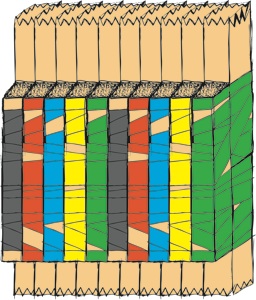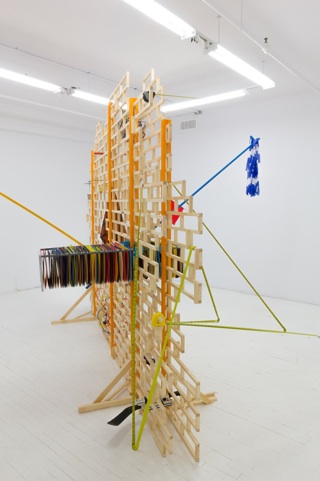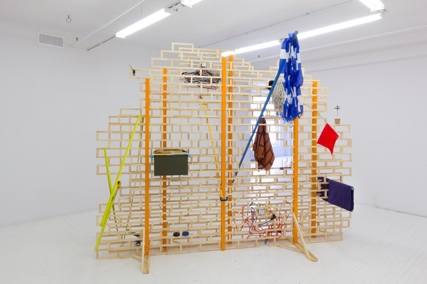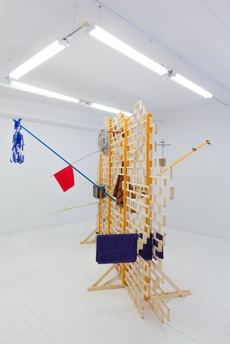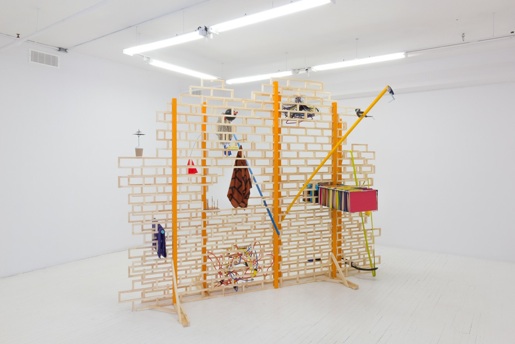Essai pratique sur l’usage en général
- Francis ARGUIN
Essai pratique sur l’usage en général – Francis Arguin
(Practical Essay on General Usage)
With Essai pratique sur l’usage en general (Practical Essay on General Usage), Francis Arguin has put together a highly unusual assemblage. Right away, the installation surprises with its absurd character, reminiscent of the Dadaist spirit. Two trellis-like gridded structures made of wood stand face to face, approximately ten centimetres separating them. These two lattice works are traversed by a variety of objects, which a priori have little connection to each other, other than the fact that they are part of the usual, useful paraphernalia found in the majority of North American households. A suction toilet plunger, a measuring tape, a bath towel, a clothes rack full of hanging shirts in a variety of colours, clothes hangars, a hockey stick covered with tape and an electric plug are part of a selection of articles the artist has chosen: objects with which he has visibly amused himself, placing them in the structure, all cut, sawn or pulled through the partitions. The trellis that provides support for the work is a reminder of the construction world. The three orange uprights of the trellis give a visual rhythm to the work’s composition and also evoke the choice colour of security signs on construction sites. Similarly, the rectangular forms of the grid in the trellises suggest that they are made of bricks. In spite of these direct references to the construction world and the relatively large size of the installation—larger than human scale, this double fence-like surface looks extremely fragile. The objects lodged between the trellises also seem to be precariously balanced, just like the entire structure, showing an omnipresence of empty spaces. Without a precise function or obvious use, apart from its size, everything about the installation is a reminder of the ephemeral structures that children cobble together in free association.
Essai pratique sur l’usage en général is the second sculptural project after Place-du-Concierge (2014), in which Francis Arguin works mainly with prefabricated objects. Rather than creating a craft-like pastiche of manufactured objects as he has done in the past, Arguin’s machined objects are integrated here almost without modification; the same is true for the structure. This change in approach towards the making and in his attitude regarding the choice of materials has both a practical and an aesthetic effect. On one hand, as the artist has admitted, this new way of proceeding allows him to save considerable time in the studio, avoiding the countless retouches necessary to satiate his fondness for perfection. On the other hand, this new approach gives his work a more industrial appearance, distancing it from the aesthetic of “cardboard décor” that was his signature mark. The assemblage of everyday objects, diverted in this way is reminiscent of today’s world in which the prefabricated and preassembled are legion.
The fact that Arguin has abandoned, or shall we say, considerably reduced the amount of manual labour in his work is not because of laziness, but rather a quest for freedom in his practise. For an artist who masters the know-how of fabrication so well, this gesture is completely audacious, but coming from him, not surprising. Recalling that Arguin was known initially for his work as a performance artist, he gradually has given up performance art to spend more time making sculpture. Although surprising for some, this transition was a natural choice for the artist. Opening up new territory seemed essential to keeping his practise alive and connected to his current interests. Far from suffering or flagging with his work, Arguin’s artistic vision has only become more precise. His interest in construction (in both the literal and semantic sense), in the meeting of reality and fiction, in the banality of the everyday and in graphic design all come together here in his playful interpretations. Although the title of the installation presented at CIRCA is a nod to different practical guides, with their lists of tips that aim to guarantee a certain performance standard when carrying out a given task, the title can also be considered from a literary point of view: the word essay referring to a personal reflection on a precise subject. Thus the installation, Essai pratique sur l’usage en général, can be read as a tangible reflection on the ordinary material culture that moulds and partially forms the fabric of our lives.
Ariane De Blois
Translated by Karen Trask
Francis Arguin is interested in design, art objects and machine-made articles of flawless appearance, as well as the handcrafted, folk-art object. Jack-of-all-trades, his art making is currently oriented towards sculpture and installation. With his work, he seeks to amuse, to surprise, to deceive and to upset. Preserving the plastic and aesthetic appearance of certain objects or details observed in everyday life, he interprets and then transforms them into what he hopes are uncommon objects.
Originally from Rouyn-Noranda, Francis Arguin lives in Quebec City. He graduated from Université Laval with two BFA Degrees, one in visual art in 2005 and the other in graphic design in 2003. In recent years, his work has been shown in many places in Québec: Le Centre Bang, Maison de la culture Frontenac, Galerie B-312, l’Œil de Poisson, and so on. He has also presented numerous performances in Quebec, Ontario, South America, the United States, Europe and Asia.
Ariane De Blois graduated with a Ph.D. in art history from McGill University in 2014 and has taught at Collège de Rosemont since 2005. She has curated numerous exhibitions:Stéphane Gilot’s Pièce pour cinq interprètes, lumière rose et silence (Havana Biennale, 2015 and Espace pfoac221 at Galerie Pierre-François Ouellet, 2014), and Et si les robots mangeaient des pommes? (Salle Alfred Pellan, Maison des arts de Laval, 2013-2014). She has also worked as co-curator for various projects such as: Rejouer/Déjouer le folklore : Switzerland–Québec (Maison de la culture Frontenac, Montréal and Stadtgalerie, Berne, 2012) and Instantes : Adad Hannah (Centro Nacional de las Artes à Mexico, 2012). She is a member of the editorial committee of esse arts + opinions magazine and on the board of directors of Musée d’art de Joliette.

